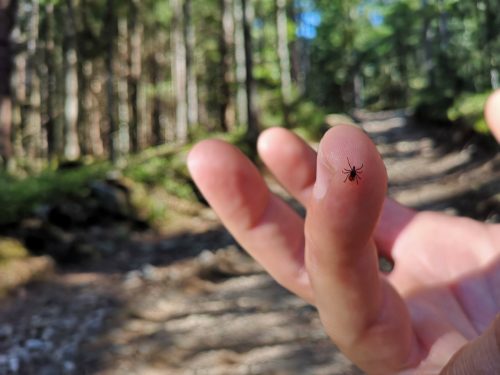5 Ways to Keep Your Dog Safe From Ticks, According to Vets
Tick treatments are important, but experts say there's more to be done to keep these pests away.
For our canine friends, the highlight of each day is often their daily walk, run, hike, or frolic in the great outdoors. But one downside of being outside is the ever-present bug army. And leading the charge are ticks. These tiny arachnid bloodsuckers feed on dogs—and people—all year round.
The Centers for Disease Control and Prevention (CDC) says that "dogs are very susceptible to tick bites and tickborne diseases," signs of which might not appear for up to 21 days after a bite. And though the vexing and sometimes debilitating Lyme disease gets a lot of attention, ticks can also infect dogs with Ehrlichiosis, Anaplasmosis, Rocky Mountain Spotted Fever, Babesiosis, Bartonellosis, and Hepatozoonosis, according to the American Kennel Club (AKC).
Luckily, there are a few simple precautions you can take to keep your pup from getting sick. Read on to hear from veterinarians about the five most important ways to keep your dog safe from ticks.
READ THIS NEXT: If You Notice This in Your Yard, Watch Out for Venomous Spiders.
1
Stick to low-tick territory.

It might sound simple, but an easy way to avoid tick bites is to avoid areas where there are a lot of ticks—mainly grassy, shrubby, and wooded areas. If you're hiking, stay in the center of the trail and not close to the fauna. And keep in mind that even places like beaches can be harboring ticks.
Where you live plays a part, too. According to the CDC, certain states have a higher prevalence of Lyme disease incidences, mainly those in the Northeast. This is also the area that, by far, sees the most emergency department visits for tick bites. Of course, these statistics are based on people, not dogs, but they're important indicators for where these pests are most common.
And even though ticks are most active between April and September, you should never let your guard down. Jenna Mahan, a registered veterinary technician and director of claims for Embrace Pet Insurance, advises pet owners that the key to true prevention is year-round consistency. "While it's true that ticks are more active during warmer months, that does not mean they disappear when temperatures drop."
2
Tick-proof your yard.

Even if your yard doesn't have tons of trees and tall leafy shrubs, it still can attract ticks. Discourage them from staying on your property by keeping the grass mowed and clearing any unnecessary weeds or brush. The CDC recommends removing any places where ticks like to hide such as leaf and wood piles and any old furniture or play equipment. They also suggest putting up a "3-ft wide barrier of wood chips or gravel between lawns and wooded areas to restrict tick migration into recreational areas."
And remember that pests attract other pests. Ticks are often found on deer, raccoons, and stray dogs, so be sure you're taking the appropriate steps to deter these animals from entering your yard. If a tick problem persists, you can also opt for pet-safe pesticides, though the CDC cautions that "you should not rely on spraying to reduce your risk of infection."
3
Tick-proof your dog.

The other important side of prevention is tick-proofing your dog. According to Mahan, dog owners should use tick-prevention products, which are available in several forms and often work against fleas, too.
Chewables or tablets are a nice option because they can be wrapped up in your pet's favorite treat. Collar systems generally last for a few months and can even be worn while swimming.
Topical liquids or gels should be applied between your dog's shoulder blades, but "pets who like to rub against you or furniture, groom themselves and others, and who have sensitive skin should be monitored if this is used to prevent them from ingesting it, as it is toxic," warns Mahan.
Whichever option you choose, you'll want to use prescription tick products from a vet as opposed to over-the-counter treatments that you can purchase in-store or online. They might be a bit pricier, but they'll be safest for your dog.
Finally, Mahan also recommends talking to your vet to see if the Lyme disease vaccine is appropriate. "If you spend time outdoors with them, chances are they might be a good candidate for it."
RELATED: For more up-to-date information, sign up for our daily newsletter.
4
Check, check, and check again.

Because you'll inevitably wander into tick territory, even if you're careful, it's important to check your pet thoroughly whenever they've spent time outside. "Check your dog daily, especially after they have been outside or for a walk in a grassy or wood environment, as it's easy for ticks to transfer from the environment onto your dog's skin," says Corinne Wigfall, a registered veterinarian and spokesperson for SpiritDog Training. "The most common places to detect ticks are in the places where the hair is thinnest. Look on the ear margins, around your dog's eyes, in their armpits or in their groin, and in between their toes."
If you find one tick, look even more carefully for more, and check later throughout the day. Ticks will enlarge after a blood meal, which makes them easier to spot.
And don't forget to check yourself, too. If it's possible your dog picked up a tick, it's just as possible that you did. In addition to a body check, showering is advisable.
5
Know how to remove ticks.

If you see a tick on Fido, remove it as quickly as possible to reduce the chance of tick-borne disease, but be sure you do it the correct way. "If you find a tick, which can be mistaken for a small growth or wart on your dog's skin, it can be tempting to simply pull it off," says Wigfall. "However, if you do this, you risk leaving the mouthpart stuck in your dog's skin which is dangerous, as infectious diseases can still be transmitted to your dog."
Instead, Wigfall's advice is to immediately give your dog a preventative (like those listed above) and contact your vet, who will safely remove it with a special tick removal tool and will then check under the microscope that it's completely gone. If this isn't an option, say you're out on a hike, Wigfall does note that these tools can be purchased online. If you go this route, she cautions that "it's important to not twist or pull at odd angles as you risk leaving the mouthpiece in the skin."
Another at-home treatment comes recommended by Mahan. "Clean the area with rubbing alcohol first, then get as close to the head of the tick as you can with a pair of sharp, pointy tweezers (think more like for splinter removal than for cosmetic uses) and pull straight up. Make sure to clean the area again with more rubbing alcohol to sanitize it."
But, of course, seeing a vet is always the best option, even if you think you've gotten the tick off your dog.






















